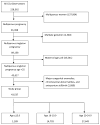Adverse Maternal and Neonatal Outcomes in Adolescent Pregnancy
- PMID: 26327561
- PMCID: PMC4886236
- DOI: 10.1016/j.jpag.2015.08.006
Adverse Maternal and Neonatal Outcomes in Adolescent Pregnancy
Abstract
Study objective: To investigate the outcomes of adolescent pregnancy.
Design: Retrospective cohort study from the Consortium on Safe Labor between 2002 and 2008.
Setting: Twelve clinical centers with 19 hospitals in the United States.
Participants: Nulliparous women (n = 43,537) younger than 25 years of age, including 1189 younger adolescents (age ≤ 15.9 years), 14,703 older adolescents (age 16-19.9 years), and 27,645 young adults (age 20-24.9 years).
Interventions: Adjusted odds ratio (aOR) with 95% confidence interval (CI) were calculated, controlling for maternal characteristics and pregnancy complications (young adults as a reference group).
Main outcome measures: Maternal, neonatal outcomes, cesarean indications, and length of labor.
Results: Younger adolescents had an increased risk of maternal anemia (aOR = 1.25; 95% CI, 1.07-1.45), preterm delivery at less than 37 weeks of gestation (aOR = 1.36; 95% CI, 1.14-1.62), postpartum hemorrhage (aOR = 1.46; 95% CI, 1.10-1.95), preeclampsia or hemolysis, increased liver enzyme levels, and low platelet syndrome (aOR = 1.44; 95% CI, 1.17-1.77) but had a decreased risk of cesarean delivery (aOR = 0.49; 95% CI, 0.42-0.59), chorioamnionitis (aOR = 0.63; 95% CI, 0.47-0.84), and neonatal intensive care unit admission (aOR = 0.80; 95% CI, 0.65-0.98). Older adolescents had an increased risk of maternal anemia (aOR = 1.15; 95% CI, 1.09-1.22), preterm delivery at less than 37 weeks of gestation (aOR = 1.16; 95% CI, 1.08-1.25), and blood transfusion (aOR = 1.21; 95% CI, 1.02-1.43), but had a decreased risk of cesarean delivery (aOR = 0.75; 95% CI, 0.71-0.79), chorioamnionitis (aOR = 0.83; 95% CI, 0.75-0.91), major perineal laceration (aOR = 0.82; 95% CI, 0.71-0.95), and neonatal intensive care unit admission (aOR = 0.89; 95% CI, 0.83-0.96). Older adolescents were less likely to have a cesarean delivery for failure to progress or cephalopelvic disproportion (aOR = 0.89; 95% CI, 0.81-0.98). For adolescents who entered spontaneous labor, the second stage of labor was shorter (P < .01).
Conclusion: Adolescents were less likely to have a cesarean delivery. Failure to progress or cephalopelvic disproportion occurred less frequently in older adolescents. Adolescents who entered spontaneous labor had a shorter second stage of labor.
Keywords: Cesarean delivery; Length of labor; Pregnancy in adolescence; Pregnancy outcomes.
Copyright © 2016 North American Society for Pediatric and Adolescent Gynecology. Published by Elsevier Inc. All rights reserved.
Conflict of interest statement
References
-
- World Health Organization (WHO) WHO guidelines on preventing early pregnancy and poor reproductive outcome among adolescents in developing countries. Geneva: WHO; 2011. - PubMed
-
- Martin JA, Hamilton EB, Osterman JK, et al. Centers for Disease Control and Prevention National Center for Health Statistics National Vital Statistics System. Births: final data for 2012. Natl Vital Stat Rep. 2013;62:1–67. - PubMed
-
- Darroch JE, Singh S, Frost JJ. Differences in teenage pregnancy rates among five developed countries: the roles of sexual activity and contraceptive use. Family Planning Perspectives. 2001;33(5):244–250. 281. - PubMed
-
- Maiden K, Gunter WD, Martin SS, et al. Teen mothers, unintended pregnancies, and costs across Delaware. Del Med J. 2014;86(4):109–16. - PubMed
-
- Kingston D, Heaman M, Fell D, et al. Comparison of adolescent, young adult, and adult women’s maternity expericences and practices. Pediatrics. 2012;129:e 1228–1237. - PubMed
Publication types
MeSH terms
Grants and funding
LinkOut - more resources
Full Text Sources
Other Literature Sources
Medical


